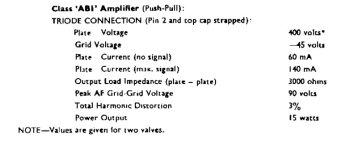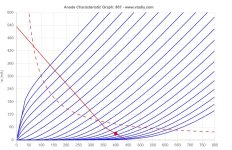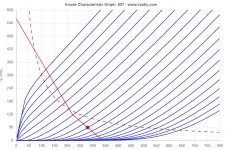Hello,
A couple of years ago I bought a pair of big mains toroids from a surplus shop with the intention to try them as PP output transformers. The feature that caught my attention was a 37-0-37V low current secondary winding that I intended to use for CFB, cathode feedback. Together with 2*115V primaries and a high current 19V secondary that would make a 2k:8R OPT with ~25% CFB taps. Practical tests revealed that the transformers worked fairly well although they, as expected, had to be downrated quite a bit for fullrange use.
More about the transformers and my prototype in this thread: https://www.diyaudio.com/community/...ers-as-opts-with-a-little-twist.374308/page-2
As I can remember those transformer did sound quite good and it would be fun to build something with them one day. Sweep tubes would be the obvious choice, either one pair of PL519 (40KG6) or a quad of PL84 (15CW5) per channel as I have plenty of those.
On the other hand I'm getting old (44...) and bored and it would be more fun to build something a bit more... eccentric. I love the look of old 807s and I have a box full of them, including some decently matched quads.
The STC "807 bible" mentions that a pair of triode wired 807s can deliver 15W into 3k p-p at 400V, as seen in the first screenshot. The second picture shows my interpretation of this OP in the vtadiy.com loadline calculator. The third pic shows a 2k p-p loadline at 280V, here the simulator indicates 3,6W in class A1 and 26W in AB2.
AB2 and 25% CFB would require a very serious driver stage, but nothing that can't be done with direct coupled Mosfet followers (PowerDrive) and a much higher voltage rail for the voltage amplification stage preceeding the mosfets. Is this whole idea completely crazy or could it possibly work, perhaps even sound decent?



A couple of years ago I bought a pair of big mains toroids from a surplus shop with the intention to try them as PP output transformers. The feature that caught my attention was a 37-0-37V low current secondary winding that I intended to use for CFB, cathode feedback. Together with 2*115V primaries and a high current 19V secondary that would make a 2k:8R OPT with ~25% CFB taps. Practical tests revealed that the transformers worked fairly well although they, as expected, had to be downrated quite a bit for fullrange use.
More about the transformers and my prototype in this thread: https://www.diyaudio.com/community/...ers-as-opts-with-a-little-twist.374308/page-2
As I can remember those transformer did sound quite good and it would be fun to build something with them one day. Sweep tubes would be the obvious choice, either one pair of PL519 (40KG6) or a quad of PL84 (15CW5) per channel as I have plenty of those.
On the other hand I'm getting old (44...) and bored and it would be more fun to build something a bit more... eccentric. I love the look of old 807s and I have a box full of them, including some decently matched quads.
The STC "807 bible" mentions that a pair of triode wired 807s can deliver 15W into 3k p-p at 400V, as seen in the first screenshot. The second picture shows my interpretation of this OP in the vtadiy.com loadline calculator. The third pic shows a 2k p-p loadline at 280V, here the simulator indicates 3,6W in class A1 and 26W in AB2.
AB2 and 25% CFB would require a very serious driver stage, but nothing that can't be done with direct coupled Mosfet followers (PowerDrive) and a much higher voltage rail for the voltage amplification stage preceeding the mosfets. Is this whole idea completely crazy or could it possibly work, perhaps even sound decent?



There are some interesting Geloso amplifiers that drive the 807 into AB2. In the 3rd one, the G275A, I think it is clever how the heater supply for the 12SL7 driver tubes is combined with the bias supply.



piano3 and Kay: 2048R : 8R is correct, the secondary voltages are measured unloaded. The transformers also have 18 and 27V windings but unfortunately only one of each so I can't think of any use for them in this application.
OldHector: Nice schemos you have there! Using 807s in class AB2 is well documented and seems to work quite well, I aready have a pair of mono blocks with triode wired 807s operating at about 290V into 5,6k p-p, giving 13W thanks to high gm cathode followers direct coupled to the grids.
I'm curious how much 25% CFB would be able to compensate for the steep loadline when using 2k p-p load for a pair of 807s.
OldHector: Nice schemos you have there! Using 807s in class AB2 is well documented and seems to work quite well, I aready have a pair of mono blocks with triode wired 807s operating at about 290V into 5,6k p-p, giving 13W thanks to high gm cathode followers direct coupled to the grids.
I'm curious how much 25% CFB would be able to compensate for the steep loadline when using 2k p-p load for a pair of 807s.
It won't. 2 kΩ just is too low for a pair of 807's, unless you intend to operate it at some rather low plate voltage, which decreases efficiency considerably. OTOH, two pairs in parallel will work safely at about 500 V without stretching the plate dissipation ratings too much.
Best regards!
Best regards!
I had a simulation with 807 AB2 PP triode so I tried it out with that transformer. I checked the CFB arrangement (37V winding at the cathode, 115 winding at the plate) as well as conventional (37V winding in series with 115V winding at the plate). Up front is 6AU6 LTP + mosfet powerdrive. No global NFB, 280V B+, 60mA bias. The CFB arrangement had distortion of 1.8% @20W and output impedance of 4 ohms (8 ohm secondary). The conventional arrangement had distortion of 1.95% @20W and output impedance of 12 ohms. BUT if you use the extra gain of the conventional arrangement to add global NFB to match the gain of the CFB arrangement, you end up with distortion of 1.05% and output impedance of 3.9 ohms. Definitely doable, but the benefits of CFB are slight if any.
Kay Pirinha - using a mains toroid for an output transformer forces low voltage / low Raa to allow reasonable power at lower frequencies. There aren't enough turns on the primary for higher voltage operation at <50Hz. Always compromises...
Kay Pirinha - using a mains toroid for an output transformer forces low voltage / low Raa to allow reasonable power at lower frequencies. There aren't enough turns on the primary for higher voltage operation at <50Hz. Always compromises...
Kay: Yes, I realize that 2k is really low for a pair of 807s. Two pairs per channel would be a much better match but I don't have any octets at home (though I could cash up for some Russian G-807s) and the power transformer I intend to use cannot provide enough heater current for eight 807s.
Also, the output transformers can only handle 20-30W for fullrange use, so using a quad of 807s per channel would be a bit wasteful.
tikiroo: Thanks for running the sims for me! As I don't know anything about the inter-winding insulation in these transformers I wouldn't be comfortable using the 37-0-37V windings directly in series with the primaries. When used for CFB they will be at the same DC potential as the 19V secondaries and properly insulated from the 115V windings.
I guess using both CFB and global feedback could result in some decent distortion and output Z numbers (and probably a transistor-like sound).
Also, the output transformers can only handle 20-30W for fullrange use, so using a quad of 807s per channel would be a bit wasteful.
tikiroo: Thanks for running the sims for me! As I don't know anything about the inter-winding insulation in these transformers I wouldn't be comfortable using the 37-0-37V windings directly in series with the primaries. When used for CFB they will be at the same DC potential as the 19V secondaries and properly insulated from the 115V windings.
I guess using both CFB and global feedback could result in some decent distortion and output Z numbers (and probably a transistor-like sound).
You will never get 15W @400V. I played very much with the 807, here is my version:
https://www.diyaudio.com/community/threads/push-pull-807-amplifier-without-global-nfb.384100/
Although the title says "without global NFB", at the end I followed the mainstream: pentode with some small amount of negative feedback. It measures and sounds good.
https://www.diyaudio.com/community/threads/push-pull-807-amplifier-without-global-nfb.384100/
Although the title says "without global NFB", at the end I followed the mainstream: pentode with some small amount of negative feedback. It measures and sounds good.
Icsaszar: Nice amp! It looks like you have coupling caps between the cathode followers and the output tubes? That would make AB2 operation impossible, resulting in a very limited output power in triode mode. My crude simulations shows that the grids would have to be pushed to +30V for full output power (26W).
I made. A different output with 807 then EL34 and toroids: i used it as a cathode follower. Primary 110+110; sec 13+13, i used it //, wicht I could do as it was bifilair wound. No feedback. It was great, nice warm sound. Pure class A? i guess.
It drove my ESL 57. Good highs.
It drove my ESL 57. Good highs.
- Home
- Amplifiers
- Tubes / Valves
- Plate Z ruminations